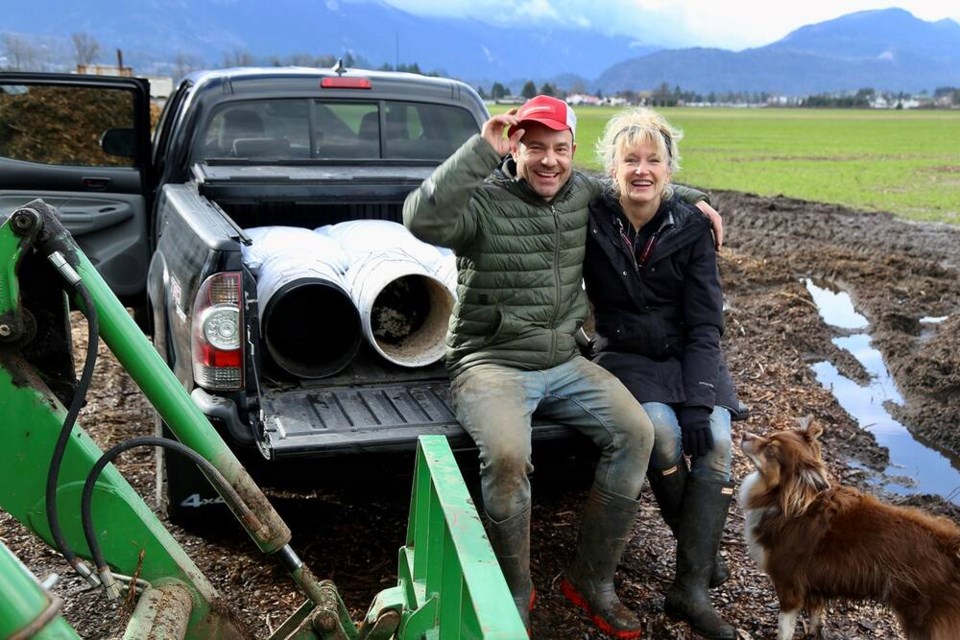Spring is in the air. Or it was before the snow dampened my budding enthusiasm.
Today, I was spreading fungal dominant compost over snow-covered raised beds. Interestingly, I found it very satisfying and easy, relative to the considerably slower process of placing uniform shovels-full strategically, over dodgy layers of leaves and winter mulch.
Just last weekend I was ankle-deep in spring-soddened farmland surrounding Terra Flora Soilworks in Chilliwack. The air was warm and redolent of soil-borne bacteria, fungi, minerals, macro and micro-nutrients, manures, worm castings, dead or dying organic matter, and the promise of sunshine.
The omni-present stacks of five-gallon Rona buckets that stand in for a little green digger – I fill them alternatively with sod for removal or compost for feeding and mulching – made the trip out to the Soilworks. The filling, loading, un-loading and emptying of buckets have made urban farming accessible and manageable. Forty neat and tidy buckets full of material equal one cubic yard, and one dozen more-or-less fit upright in the back of the average SUV. It takes four to five buckets full to top-up a standard four-by-five foot raised bed, seasonally.
Twice per year at least – once just before spring, and again late in the fall, we visit Terra Flora proprietor Andrew Couzens in his high tunnel lab on the farm. We trade stories and inspiration, and geek-out over his soil biology innovations. This year, Andrew created a custom “living” seed-starting soil blend for us, using un-sulphured molasses and vermicast inoculated biochar as a nutrient-depository binding agent. Also, I am trialling his specialty blends, formulated for soil blocking and heavy feeders.
I am excited to try his super-charged improvements on my original recipe, and enjoy the demonstrable benefits of the trace minerals, kelp, fish amino acids, insect frass and other supplements that he prescribes for increasing yield, water retention, porosity and overall nutrient density.
To make room in the pantry this spring for brooding chicks, I hope to reduce our indoor seed-starting space by half, without reducing yield. My plan is to swap-out our 36-cell trays for 72-cell trays I’ve been saving. To seed start in tiny cells, the growing medium should be extra small-grained, but still hold water well without compacting. The perlite or pumice should be smaller grained as well, to both aerate and distribute water equally throughout, and to allow for unimpeded seeding, germination, and root set.
Andrew’s carbon-rich, super-fine blend is beautifully lofty and required no secondary sifting. I ran our perlite through an inexpensive eighth-of-an-inch sieve, before incorporating – reserving the larger pieces for later use.
I have learned through experience that growing vegetables from seed in living soil, creates hardy plants that can manage less heat after potting up, sooner than plants grown in sterile seed mix.
I start seed trays on heat mats set to 22 C, then turn the heat off once germination is complete and plants are one centimetre tall. It is important to keep air circulating gently near soil level, especially when using living soil. Mimicking nature in this way trains stalks to develop breeze-sturdy strength from the get-go, and prevents possible damping-off (damp rot). Inexpensive, small clip-on fans are widely available.
Seed starting is easy and requires little investment. A sunny, double-paned window sill, or an always-warm fridge top will do nicely. Recycled take-out containers with lids, do double-duty as humidity-domed soil trays. Just be sure to poke drainage holes in the bottom.
Laura Marie Neubert is a West Vancouver-based urban permaculture designer. Follow her on Instagram @upfrontandbeautiful, learn more about permaculture by visiting her Upfront & Beautiful website or email your questions to her here.
For a taste of permaculture, watch the video below:




